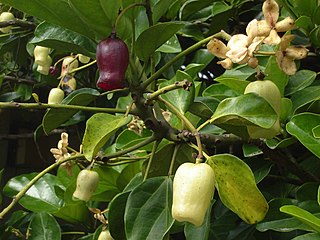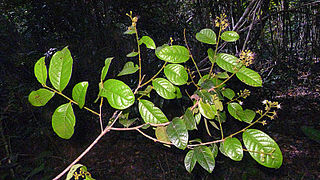
Quassia is a plant genus in the family Simaroubaceae. Its size is disputed; some botanists treat it as consisting of only one species, Quassia amara from tropical South America, while others treat it in a wide circumscription as a pantropical genus containing up to 40 species of trees and shrubs.

Chrysobalanaceae is a family of flowering plants, consisting of trees and shrubs in 27 genera and about 700 species of pantropical distribution with a centre of diversity in the Amazon. Some of the species contain silica in their bodies for rigidity and so the mesophyll often has sclerenchymatous idioblasts. The widespread species Chrysobalanus icaco produces a plum-like fruit and the plant is commonly known as the coco plum.

The genus of the myrrhs, Commiphora, is the most species-rich genus of flowering plants in the frankincense and myrrh family, Burseraceae. The genus contains approximately 190 species of shrubs and trees, which are distributed throughout the (sub-) tropical regions of Africa, the western Indian Ocean islands, the Arabian Peninsula, India, and South America. The genus is drought-tolerant and common throughout the xerophytic scrub, seasonally dry tropical forests, and woodlands of these regions.

Berlinia is a genus of flowering plants in the family Fabaceae. It includes 21 species of trees native to sub-Saharan Africa, ranging from Guinea to Chad, Tanzania, Mozambique, and Angola.

Nesogordonia is a genus of flowering plants. It ranges across tropical Africa, Madagascar, and the Comoro Islands. The majority of species are endemic to Madagascar.

Atuna is a genus of plants in the family Chrysobalanaceae described as a genus in 1838. It is native to the Indian Subcontinent, Southeast Asia, and various islands of the western Pacific.

Beilschmiedia is a genus of trees and shrubs in family Lauraceae. Most of its species grow in tropical climates, but a few of them are native to temperate regions, and they are widespread in tropical Asia, Africa, Madagascar, Australia, New Zealand, North America, Central America, the Caribbean, and South America. The best-known species to gardeners in temperate areas are B. berteroana and B. miersii because of their frost tolerance. Seeds of B. bancroftii were used as a source of food by Australian Aborigines. Timbers of some species are very valuable.

Hirtella is a genus of 110 species of woody trees in family Chrysobalanaceae. It was first described as a genus by Linnaeus in 1753. Hirtella naturally occurs in tropical forests throughout Latin America, the West Indies, southeast Africa, and Madagascar. The flowers are mainly pollinated by butterflies.
Magnistipula conrauana is a species of plant in the family Chrysobalanaceae. It is endemic to Cameroon. Its natural habitats are subtropical or tropical moist lowland forests and subtropical or tropical moist montane forests. It is threatened by habitat loss.
Magnistipula cuneatifolia is a species of plant in the family Chrysobalanaceae. It is found in Cameroon and Gabon. Its natural habitat is subtropical or tropical dry forests. It is threatened by habitat loss.

Maranthes is a genus of plant in the family Chrysobalanaceae described as a genus in 1825.

Parinari is a genus of plant in the family Chrysobalanaceae.
Eremospatha is a genus of climbing flowering plants in the palm family found in tropical Africa. These rattans are uncommon in cultivation and poorly understood by taxonomists. Closely related to Laccosperma, they are differentiated by the near complete absence of bracts and bracteoles. The name is from Greek meaning "without a spathe".

Cercestis is a genus of flowering plants in the family Araceae. The species in this genus are all climbers and are endemic to Africa. At intervals along the stem they produce long leafless shoots called flagella. Many of the species in Cersestis show signs of fenestration.

Culcasia is a genus of flowering plants in the family Araceae, native to tropical Africa. Most of its species are climbers and resemble Cercestis, except that they do not produce flagella.
- Culcasia angolensisWelw. ex Schott - western + central Africa from Senegal to Angola
- Culcasia annetiiNtépé-Nyamè - Ivory Coast, Cameroon, Liberia
- Culcasia bosiiNtépé-Nyamè - Cameroon, Gabon, Congo-Brazzaville
- Culcasia brevipetiolataBogner - Gabon
- Culcasia caudataEngl. - Zaïre
- Culcasia dinklageiEngl - western + central Africa from Liberia to Zaïre
- Culcasia ekongoloiNtépé-Nyamè - central Africa from Nigeria to Zaïre
- Culcasia falcifoliaEngl. - central Africa from Gabon east to Tanzania and south to Mozambique
- Culcasia glandulosaHepper - Ivory Coast, Sierra Leone, Liberia, Congo-Brazzaville
- Culcasia insulanaN.E.Br. - Zaïre, Cameroon, Gulf of Guinea Islands
- Culcasia lanceolataEngl. - Cameroon, Gabon
- Culcasia libericaN.E.Br. - Ivory Coast, Sierra Leone, Liberia, Togo
- Culcasia linearifoliaBogner - Cameroon, Gabon
- Culcasia loukandensisPellegr - Cameroon, Gabon, Congo-Brazzaville, Zaïre, Central African Republic
- Culcasia mannii(Hook.f.) Engl. - Cameroon, Gabon, Congo-Brazzaville, Nigeria, Equatorial Guinea
- Culcasia obliquifoliaEngl. - Cameroon, Gabon
- Culcasia orientalisMayo - Kenya, Tanzania, Mozambique, Zambia
- Culcasia panduriformisEngl. & K.Krause - Cameroon, Gabon
- Culcasia parvifloraN.E.Br. - western + central Africa from Liberia to Zaïre
- Culcasia rotundifoliaBogner - Gabon
- Culcasia sanagensisNtépé-Nyamè - Cameroon
- Culcasia scandensP.Beauv. - western + central Africa from Liberia to Angola
- Culcasia seretiiDe Wild - western + central Africa from Liberia to Zaïre
- Culcasia simiarumNtépé-Nyamè - western Africa from Ivory Coast to Cameroon
- Culcasia striolataEngl. - western + central Africa from Liberia to Congo-Brazzaville
- Culcasia tenuifoliaEngl. - western + central Africa from Liberia to Zaïre
- Culcasia yangambiensisLouis & Mullend. - Congo-Brazzaville, Zaïre

Englerophytum is a group of trees in the family Sapotaceae described as a genus in 1914.

Dichapetalum is a genus in the plant family Dichapetalaceae. The plants are tropical lianas native mainly to tropical regions of Africa, Asia, Malesia, the West Indies, Australia and Latin America. Some species are known to be poisonous due to the presence of toxic fluorinated compounds such as fluorocarboxylic acid and dichapetalins, a unique class of cytotoxic compounds that are only found within this genus.

Sapindoideae is a subfamily of flowering plants in the soapberry family, Sapindaceae. It includes a number of fruit trees, including lychees, longans, rambutans, and quenepas.
Donella is a genus of flowering plants belonging to the family Sapotaceae.
Gambeya is a genus of flowering plants belonging to the family Sapotaceae.













